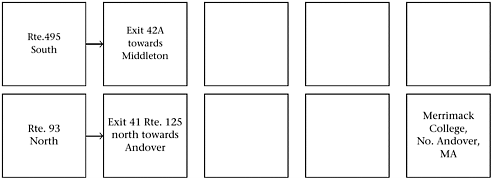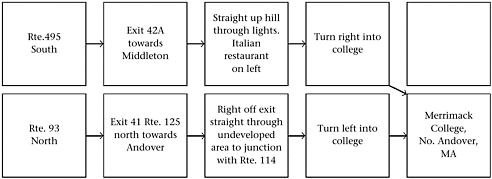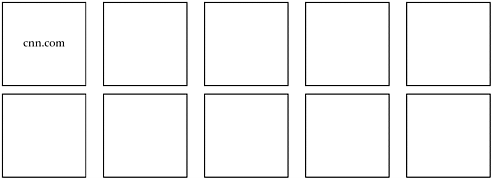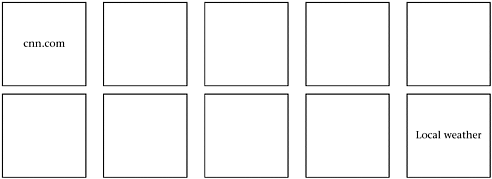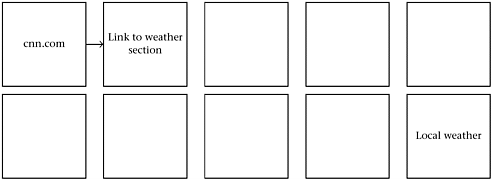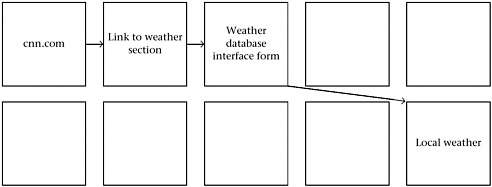Using Mapping to Build Presentations
The Internet is rife with road analogies for good reason. Though it is really made up of clients, networks, and servers, the road analogy works well for envisioning the information exchanges that take place. A road analogy is useful for envisioning and describing movements through information and transaction presentations.
Presenting information and interactivity on the Internet is similar in many ways to giving directions to a driver trying to find a specific physical location. Like the driver of a car trying to find an address, end users on the Internet must be presented with an easy-to-follow route to their information goal.
The road analogy can be used to help describe and build Web site interactions. Every Web site has a URL (uniform resource locator) or address that is particular to that site. This address can be found by anyone on the Internet and brings up the Web site's home or index page. This address is similar to a major interstate highway that any driver can find on a map. From there an exit is usually involved to bring drivers off the main highway into a smaller section of roads in a town or neighborhood. Links off a home page serve a similar role on the Internet, bringing users closer to the information they seek based on their audience needs. From this point, a series of turns or other directions lead a driver to the desired location. The same is true on the Internet, though the number of steps should be as small as possible to facilitate the process and not frustrate or confuse the end users.
Navigational aides, such as landmarks and road signs are usually included in driving directions as well. These types of elements can and should be involved in the construction of an Internet communications effort to facilitate audience access to information goals.
Directions are usually given from the perspective of the driver. The same is true with Web sites. They must be designed for the convenience of the end user. Different drivers may have different routes and different goals. The same is true on the Internet. Different audiences will have different goals requiring different presentations directing them to their goals.
Building Internet communications efforts can be facilitated through the use of flow charts to document information presentations. The end user's travel, route, or journey through the presentation can be designed using this system. A reverse engineering process will be used in this chapter to demonstrate these concepts. Reverse engineering is a process in which a final version of a project is deconstructed into its smaller parts to see how it was built. A currently active Web site can be reverse engineered to demonstrate the information goals sought by a particular audience and the route an audience member must take to reach that goal. We can look at existing Web sites and build directions and flow charts based on their presentations.
Exercises
Describe Movements in the Physical World
To demonstrate mapping Internet communication, let's take a look at how mapping is done in the physical world. Write down directions to a physical location like your house, school, or workplace from a major interstate highway.
| a) | What is the interstate highway? |
| b) | What exit do you use to get to your location and what does the exit sign say? |
| c) | What are the rest of the directions and landmarks involved? |
| d) | Is there a more complicated route that you are not explaining? |
| e) | What is the final location? |
4.1.2 Map in the Physical World
Now let's create a diagram or flow chart of this set of directions. Fill in the squares and connect them according to the directions listed in the previous exercise. If necessary, disregard unneeded boxes or add more.
| a) | Write the interstate highway number in the square in the upper left square. What does the flow chart look like?
|
| b) | Write the final location in the bottom right square. What does the flow chart look like?
|
| c) | Fill in the exit number and what the signs say next to the highway number box and connect the two boxes with an arrow. What does the flow chart look like?
|
| d) | Fill in the rest of the directions and any landmarks, with each direction in separate squares. How does this affect the flow chart?
|
| e) | Connect the squares in order until you reach the final location. What does the flow chart look like?
|
Provide Directions on the Internet
Now let's begin mapping on the Internet by describing a set of directions to the information we regularly access.
Point your Web browser to the home page of your favorite Web site.
| a) | Who operates the Web site? |
| b) | What is the URL or Web site address? |
| c) | What is the first link you click to access your information objective? |
| d) | What are the additional links or steps you took to reach your information objective? |
List any icons or other landmarks that you could or did use to reach your information objective.
| a) | How can they be described? |
| b) | What was your information objective? |
Map a Web Site Visit
Using the same grid of boxes, build a flow chart of your visit to the Web site.
| a) | Fill in the Web site home page in the upper left box. What does the flow chart look like?
|
| b) | Write your information objective in the lower right box. What does the flow chart look like?
|
| c) | Add the first link or other action you took to reach your information objective. How does this affect the appearance of the flow chart?
|
| d) | Add any additional links or steps you took to reach your information objective to individual boxes and connect the boxes in a linear fashion. What does the flow chart look like now?
|
| e) | Add any icons or other landmarks that you could or did use to reach your information objective in the appropriate box. How does this add to the appearance of the flow chart?
|
Exercise Answers
Answers
To demonstrate mapping Internet communication, let's take a look at how mapping is done in the physical world. Write down directions to a physical location like your house, school, or workplace from a major interstate highway.
| a) | What is the interstate highway? |
| Answer: | Your situation will be specific to your physical location. In describing the directions to my school, the closest interstate highway is Rt. 495 in Massachusetts. This is the best route for people coming from the north, east, and west. Another major highway is Rt. 93. This is the best route for people coming from the south. In my situation, two different audiences utilize two different sets of directions to get to the same place. It is apparent that different audiences require different routes to reach their goals. This is also true in Web site presentations. Different audiences require different presentations to meet their communication goals. |
| b) | What exit do you use to get to your location and what does the exit sign say? |
| Answer: | Your answer will be different. My answer for the first set of directions is exit 42A, which is Rt. 114 East. The second set of directions would be exit 41, which connects to Rt. 125 North. |
| c) | What are the rest of the directions and landmarks involved? |
| Answer: | Again, your answers will vary. My directions for the first group are to proceed straight through a number of traffic lights and the college campus will be on the right. Landmarks include a large hill and an Italian restraunt on the left before the campus on the right. In the second set the driver is to take a right off the exit. Next the driver proceeds several miles to the junction of Rt. 114 and Rt. 125, where the college is on the left. I usually tell people to start anticipating the intersection once development starts after a long undeveloped stretch of road. |
| d) | Is there a more complicated route that you are not explaining? |
| Answer: | Your answers will vary from mine. For both sets of directions, other routes exist that may be shorter or more direct coming from other directions. These different routes involve more complicated steps, including multiple turns and confusing intersections. Often directions that are given to a driver provide the easiest route to a location. And that easiest set of directions is given from the driver's perspective. It is the people giving directions that decide the easiest route based on the driver's needs, not their own. This is also our role in building Internet communications systems. They should be built to present information in the easiest fashion, from the end user's perspective. |
| e) | What is the final location? |
| Answer: | Your answer will be based on your situation. The final location for my directions is Merrimack College in North Andover, Massachusetts. The final location for Web end users should be their information objective. It is up to us as Web communications experts to facilitate that objective as much as possible. |
Answers
Now let's create a diagram or flow chart of this set of directions. Fill in the squares and connect them according to the directions listed in the previous exercise. If necessary, disregard unneeded boxes or add more.
| a) | Write the interstate highway number in the square in the upper left square. What does the flow chart look like?
|
| Answer: | Yours will vary. I've included both sets of directions in this exercise so mine looks like this:
|
| b) | Write the final location in the bottom right square. What does the flow chart look like?
|
| Answer: | Again yours will vary. Here's mine:
|
| c) | Fill in the exit number and what the signs say next to the highway number box and connect the two boxes with an arrow. What does the flow chart look like?
|
| Answer: | Yours will be based on your situation but will look similar to this:
|
| d) | Fill in the rest of the directions and any landmarks, with each direction in separate squares. How does this affect the flow chart?
|
| Answer: | Your answer will vary but should look something like this:
|
| e) | Connect the squares in order until you reach the final location. What does the flow chart look like?
|
| Answer: | Again, your answer will differ. Mine looks like this:
|
Answers
Now let's look at mapping on the Internet by building a set of directions to the information we regularly access.
Point your Web browser to the home page of your favorite Web site.
| a) | Who operates the Web site? |
| Answer: | Your answer will be different based on your favorite Web site. My answer is CNN's Web site. |
| b) | What is the URL or Web site address? |
| Answer: | Yours will vary accordingly. Mine iswww.cnn.com |
| c) | What is the first link you click to access your information objective? |
| Answer: | Your answer will be based on your specifications. In my situation I clicked on a link to the weather section. |
| d) | What are the additional links or steps you took to reach your information objective? |
| Answer: | You will have a different experience. In my situation a screen came up that provided a form to fill in my zip code or closest city, which I did. After pressing the submit button, a database interaction produced a screen with the latest weather information and a forecast for my city. |
List any icons or other landmarks that you could or did use to reach your information objective.
| a) | How can they be described? |
| Answer: | Your answer will differ. In my situation, I clicked on the word "weather" in a list of general topics on the index page of the site. The next screen I saw had a heading, text, graphics, and advertisements related to weather. |
| b) | What was your information objective? |
| Answer: | Your answer will define why this is your favorite site; mine is the local weather. |
Answers
Using the same grid of boxes, build a flow chart of your visit to the Web site.
| a) | Fill in the Web site home page in the upper left box. What does the flow chart look like?
|
| Answer: | Yours will vary but should look similiar to this:
Pulling up a Web site can be likened to a subset of linked pages on the information superhighway. The first step in giving physical directions to describe a single, large location that any person can find on a map. When mapping a Web site visit, the index or home page can serve as that initial starting point. There is only one URL like it on the Internet, and anyone can find it. |
| b) | Write your information objective in the lower right box. What does the flow chart look like?
|
| Answer: | Your answer will be different. My flow chart now looks like this:
When building Web sites for Internet communication, it is imperative that the architecture be based on the information objectives of the audience. That is why we listed our objectives on the flow chart first in this exercise. |
| c) | Add the first link or other action you took to reach your information objective. How does this affect the appearance of the flow chart?
|
| Answer: | Your answers will vary. My answer was to click on a link to a weather section.
The second step I took here, after pulling up the URL, was to choose a specific grouping of information. Referring to the previous exercise, this can be compared to the exit off the highway. This exit off the index page sends us into a smaller subgroup of information close to our objective. |
| d) | Add any additional links or steps you took to reach your information objective to individual boxes and connect the boxes in a linear fashion. What does the flow chart look like now?
|
| Answer: | Your answer will differ. Mine looks like this:
This next step actually involved a couple of substeps, which are combined here for clarity's sake. I entered a zip code and pressed the submit button. The database returned the information I was seeking. This is also similar to a physical set of directions that usually include a number of small course changes upon nearing the desired location. Also similar to physical directions, the route to the information goal should be very easy for the end user. |
| e) | Add any icons or other landmarks that you could or did use to reach your information objective in the appropriate box. How does this add to the appearance of the flow chart?
|
| Answer: | 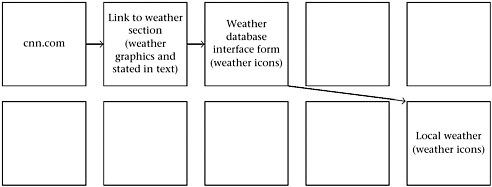 As with landmarks in the physical world, we can help end users of Web sites to locate their information goals with clear and obvious navigational aids. We can also provide appropriate icons, graphics, and information to help identify what information presentations they are currently seeing and how to access other types of information and interaction. |
Self-Review Questions
In order to test your progress, you should be able to answer the following questions:
| 1) | An Internet communications presentation can be described
|
| 2) | Road directions are given from the perspective of the person giving the directions.
|
| 3) | A highway exit is similar to
|
| 4) | A communications goal is similar to
|
| 5) | When mapping a presentation, the following are useful:
|
| 6) | Building a successful communications effort requires
|
EAN: 2147483647
Pages: 87












